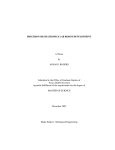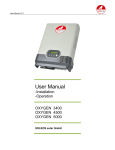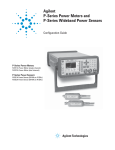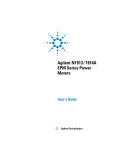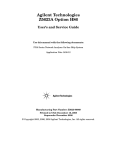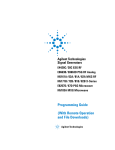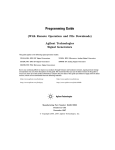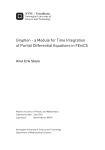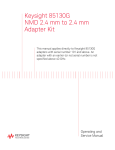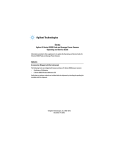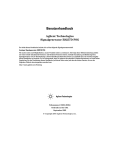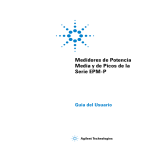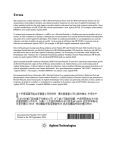Download N1921A Operating Guide
Transcript
Operating and Service Guide P-Series Wideband Power Sensor N1921A and N1922A Manufacturing Part Number: N1920-90007 Printed in Malaysia Fifth Edition, October 10, 2012 © Copyright Agilent Technologies Inc, 2005–2012 Notices No part of this manual may be reproduced in any form or by any means (including electronic storage and retrieval or translation into a foreign language) without prior agreement and written consent from Agilent Technologies, Inc. as governed by United States and international copyright laws. Agilent Technologies, Inc. Bayan Lepas Free Industrial Zone 11900 Penang, Malaysia ii General Warranty The material contained in this document is provided “as is,” and is subject to being changed, without notice, in future editions. Further, to the maximum extent permitted by applicable law, Agilent disclaims all warranties, either express or implied with regard to this manual and any information contained herein, including but not limited to the implied warranties of merchantability and fitness for a particular purpose. Agilent shall not be liable for errors or for incidental or consequential damages in connection with the furnishing, use, or performance of this document or any information contained herein. Should Agilent and the user have a separate written agreement with warranty terms covering the material in this document that conflict with these terms, the warranty terms in the separate agreement will control. Certification Agilent Technologies certifies that this product met its published specifications at the time of shipment from the factory. Agilent Technologies further certifies that its calibration measurements are traceable to the United States National Institute of Standards and Technology, to the extent allowed by the Institute’s calibration facility, and to the calibration facilities of other International Standards Organization members. Safety Symbols The following symbols on the instrument and in the documentation indicate precautions which must be taken to maintain safe operation of the instrument. iii The Instruction Documentation Symbol. The product is marked with this symbol when it is necessary for the user to refer to the instructions in the supplied documentation. ESD ISM GRP.1 CLASS A This symbol indicates that a device, or part of a device, may be susceptible to electrostatic discharges (ESD) which can result in damage to the product. Observe ESD precautions given on the product, or its user documentation, when handling equipment bearing this mark. This is the symbol of an Industrial Scientific and Medical Group 1 Class A product. The CE mark shows that the product complies with all relevant European Legal Directives. ICES/NMB-001 This ISM device complies with Canadian ICES-001. Cet appareil ISM est conforme à la norme NMB-001 du Canada. N10149 The C-Tick mark is a registered trademark of the Australian Communications Authority. This signifies compliance with the Australian EMC Framework Regulations under the terms of the Radio Communications Act of 1992. Safety Notices This guide uses warnings and cautions to denote hazards WARNING A warning calls attention to a procedure, practice or the like, which, if not correctly performed or adhered to, could result in injury or loss of life. Do not proceed beyond a warning until the indicated conditions are fully understood and met. iv CAUTION A caution calls attention to a procedure, practice or the like which, if not correctly performed or adhered to, could result in damage to or the destruction of part or all of the equipment. Do not proceed beyond a caution until the indicated conditions are fully understood and met. General Safety Information The following general safety precautions must be observed during all phases of operation, service, and repair of this instrument. Failure to comply with these precautions or with specific warnings elsewhere in this manual violates safety standards of design, manufacture, and intended use of the instrument. Agilent Technologies assumes no liability for the customer’s failure to comply with these requirements. WARNING BEFORE CONNECTING THE POWER SENSOR TO OTHER INSTRUMENTS ensure that all instruments are connected to the protective (earth) ground. Any interruption of the protective earth grounding will cause a potential shock hazard that could result in personal injury. Sound Emission Herstellerbescheinigung Diese Information steht im Zusammenhang mit den Anforderungen der Maschinenlarminformationsverordnung vom 18 Januar 1991. • Sound Pressure LpA < 70 dB. • Am Arbeitsplatz. • Normaler Betrieb. v • Nach DIN 45635 T. 19 (Typprufung). Manufacturers Declaration This statement is provided to comply with the requirements of the German Sound DIN 45635 T. 19 (Typprufung). • Sound Pressure LpA < 70 dB. • At operator position. • Normal operation. • According to ISO 7779 (Type Test). vi Contents 1 Introduction What You’ll Find In This Chapter . . . . . . . . . . . . . . . . . . . . . . . . . . . . . . . . . . . . . . . . . . . . . . . . . . . . General Information. . . . . . . . . . . . . . . . . . . . . . . . . . . . . . . . . . . . . . . . . . . . . . . . . . . . . . . . . . . . . . . Initial Inspection . . . . . . . . . . . . . . . . . . . . . . . . . . . . . . . . . . . . . . . . . . . . . . . . . . . . . . . . . . . . . . . Power Meter and Sensor Cable Requirements. . . . . . . . . . . . . . . . . . . . . . . . . . . . . . . . . . . . . . . . . Interconnections . . . . . . . . . . . . . . . . . . . . . . . . . . . . . . . . . . . . . . . . . . . . . . . . . . . . . . . . . . . . . . . . Recommended Calibration Interval . . . . . . . . . . . . . . . . . . . . . . . . . . . . . . . . . . . . . . . . . . . . . . . . . Calibration . . . . . . . . . . . . . . . . . . . . . . . . . . . . . . . . . . . . . . . . . . . . . . . . . . . . . . . . . . . . . . . . . . . . . . Overview of the P-Series Wideband Power Sensors . . . . . . . . . . . . . . . . . . . . . . . . . . . . . . . . . . . . . . The Internal Zero and Calibration . . . . . . . . . . . . . . . . . . . . . . . . . . . . . . . . . . . . . . . . . . . . . . . . . . 2 3 3 4 4 4 6 7 7 2 Performance Tests and Adjustments Test Equipment . . . . . . . . . . . . . . . . . . . . . . . . . . . . . . . . . . . . . . . . . . . . . . . . . . . . . . . . . . . . . . . . . Voltage Standing Wave Ratio (VSWR) Performance Test . . . . . . . . . . . . . . . . . . . . . . . . . . . . . . . . Sensor Accuracy Performance Test . . . . . . . . . . . . . . . . . . . . . . . . . . . . . . . . . . . . . . . . . . . . . . . . . . System-Level Rise and Fall Time Performance Test. . . . . . . . . . . . . . . . . . . . . . . . . . . . . . . . . . . . . Zero Set Performance Test in System Level . . . . . . . . . . . . . . . . . . . . . . . . . . . . . . . . . . . . . . . . . . . Adjustment. . . . . . . . . . . . . . . . . . . . . . . . . . . . . . . . . . . . . . . . . . . . . . . . . . . . . . . . . . . . . . . . . . . . . 12 13 14 19 22 24 3 Theory of Operation Theory of Operation . . . . . . . . . . . . . . . . . . . . . . . . . . . . . . . . . . . . . . . . . . . . . . . . . . . . . . . . . . . . . 26 4 Specifications and Characteristics Introduction . . . . . . . . . . . . . . . . . . . . . . . . . . . . . . . . . . . . . . . . . . . . . . . . . . . . . . . . . . . . . . . . . . . . Specification Definitions . . . . . . . . . . . . . . . . . . . . . . . . . . . . . . . . . . . . . . . . . . . . . . . . . . . . . . . . Specifications. . . . . . . . . . . . . . . . . . . . . . . . . . . . . . . . . . . . . . . . . . . . . . . . . . . . . . . . . . . . . . . . . . . Frequency and Dynamic Power Range . . . . . . . . . . . . . . . . . . . . . . . . . . . . . . . . . . . . . . . . . . . . . Damage Level and RF Connector Type . . . . . . . . . . . . . . . . . . . . . . . . . . . . . . . . . . . . . . . . . . . . . Power Sensor Maximum SWR . . . . . . . . . . . . . . . . . . . . . . . . . . . . . . . . . . . . . . . . . . . . . . . . . . . Power Sensor Calibration Uncertainty. . . . . . . . . . . . . . . . . . . . . . . . . . . . . . . . . . . . . . . . . . . . . . Physical Characteristics . . . . . . . . . . . . . . . . . . . . . . . . . . . . . . . . . . . . . . . . . . . . . . . . . . . . . . . . . Declaration of Conformity. . . . . . . . . . . . . . . . . . . . . . . . . . . . . . . . . . . . . . . . . . . . . . . . . . . . . . . . . 30 30 32 32 32 33 34 35 36 5 Service What You’ll Find In This Chapter . . . . . . . . . . . . . . . . . . . . . . . . . . . . . . . . . . . . . . . . . . . . . . . . . . . General Information. . . . . . . . . . . . . . . . . . . . . . . . . . . . . . . . . . . . . . . . . . . . . . . . . . . . . . . . . . . . . . Cleaning . . . . . . . . . . . . . . . . . . . . . . . . . . . . . . . . . . . . . . . . . . . . . . . . . . . . . . . . . . . . . . . . . . . . . Connector Cleaning . . . . . . . . . . . . . . . . . . . . . . . . . . . . . . . . . . . . . . . . . . . . . . . . . . . . . . . . . . . . 38 39 39 39 vii Contents Performance Test . . . . . . . . . . . . . . . . . . . . . . . . . . . . . . . . . . . . . . . . . . . . . . . . . . . . . . . . . . . . . . 39 Agilent Sales and Service Offices . . . . . . . . . . . . . . . . . . . . . . . . . . . . . . . . . . . . . . . . . . . . . . . . . . . 40 viii 1 Introduction 1 What You’ll Find In This Chapter This Chapter introduces you to the P-Series Wideband Power Sensors. It contains the following sections: • “General Information” on page 3. • “Initial Inspection” on page 3. • “Power Meter and Sensor Cable Requirements” on page 4. • “Interconnections” on page 4. • “Calibration” on page 6. • “Overview of the P-Series Wideband Power Sensors” on page 7. 2 General Information Welcome to the P-Series Wideband Power Sensors Operating and Service Guide. This guide contains information about the initial inspection, connection, and specifications of the P-Series Wideband Power Sensors. You can also find a copy of this guide on the Documentation CD-ROM supplied with the P-series power meters. Figure 1-1 P-Series Wideband Power Sensors To make best use of your sensor refer to the chapter “Using P-Series Power Sensors” in the P-Series Power Meter User’s Guide. Initial Inspection Inspect the shipping container for damage. If the shipping container or packaging material is damaged, it should be kept until the contents of the shipment have been checked mechanically and electrically. If there is mechanical damage, notify the nearest Agilent office. Keep the damaged shipping materials (if any) for inspection by the carrier and an Agilent representative. See “Agilent Sales and Service Offices” on page 40. 3 Power Meter and Sensor Cable Requirements The P-Series Wideband Power Sensors are ONLY compatible with the P-Series Power Meters. Table 1-1 lists the length of cable option, these have no interconnecting cable requirements, as the cable is permanently connected (hard-wired) to the P-Series Wideband power sensor. Table 1-1 Cable Length Options Option Description N1921A-105 N1922A-105 1.5m (5-ft) cable length N1921A-106 N1922A-106 3m (10-ft) cable length N1921A-107 N1922A-107 10m (31-ft) cable length Interconnections Connect the cable to the P-Series power meter’s channel input. Figure 1-2 shows that you must align the red dot on the sensor’s cable and the meter’s connector. WARNING BEFORE CONNECTING THE POWER SENSOR TO OTHER INSTRUMENTS ensure that all instruments are connected to the protective (earth) ground. Any interruption of the protective earth grounding will cause a potential shock hazard that could result in personal injury. Recommended Calibration Interval Agilent Technologies recommends a one-year calibration cycle for the P-Series power sensors. 4 Figure 1-2 Connecting a Sensor Cable to a Power Meter Ensure you line up the red dots on the sensor cable and power meter’s connector Allow a few seconds for the power meter to read the data contained in the power sensor’s EEPROM. NOTE Ensure power sensor cables are attached and removed in an indoor environment. Torque Table 1-2 shows the connector type (for connection to DUT) for the power sensor models. A torque wrench must be used to tighten these connectors. Only use a wrench set to the correct torque value. Table 1-2 Wrench Size and Torque Values Model Connector Wrench Size Torque Value N1921A Type-N (male) 3/4-inch open-end 12 in-lb (135 Ncm) N1922A 2.4 mm (male) 5/16-inch open-end 8 in-lb (90 Ncm) 5 Calibration When calibrating a P-Series Wideband Power Sensor, there is no need to disconnect it from the power source. The power meter performs Internal Zero and Calibration routines. The process used for this Internal Zero and Calibration is explained in “Overview of the P-Series Wideband Power Sensors” on page 7. The chapter “Using P-Series Power Sensors” in the P-Series Power Meter User’s Guide explains in more detail the methods used the perform the zero and calibration of the power sensor. 6 Overview of the P-Series Wideband Power Sensors The P-Series Wideband Power Sensors has two different models. • The N1921A has a frequency range of 50 MHz to 18 GHz. • The N1922A has a frequency range of 50 MHz to 40 GHz. The Internal Zero and Calibration The P-Series Wideband Power Sensor’s Internal Zero and Calibration process is used to combine the power sensor and power meter to make accurate power measurements. Referring to Figure1-3, Simplified Sensor Block Diagram, the process for the Internal Zero and Calibration explains how three objectives in this process are achieved. Figure 1-3 Simplified Sensor Block Diagram 1. To account for the environment that the system is working in - the temperature and the presence of electromagnetic signals. This is achieved during the Internal Zero process, where the Diode Detectors are isolated from the active amplifier circuitry. The process allows the zero measurement to be made, regardless of the RF input signal, thus allowing the sensor to remain connected to the DUT. The isolation is achieved by a network of transistor switches in the zero and calibration path switching. 2. To account for the combining of the sensor and meter, as these may never have been used together as a system. 7 This is achieved during the Internal Calibration, the Amplifier Circuitry is isolated from the Diode Detectors by a network of transistor switches and the sensor’s voltage reference is routed to the Amplifier Circuitry. 3. To verify traceability to National Standards, hence, verifying your measurements are going to perform to specification. To achieve traceable and accurate RF power measurements, each sensor is individually characterized during its production procedure. To achieve optimal accuracy, a 3-dimensional correction is generated across power, frequency and temperature. This uses advanced modeling techniques, and is superior in accuracy and speed of evaluation to the overlaying of linearity, temperature corrections and calibration factors. As a confidence check of the connector integrity, the P-Series Wideband Power Sensor can be connected to any known good signal source (for example, the 50 MHz, 0 dBm reference) and a comparison made. The calibration factors are stored in the EEPROM during the manufacturing process. All the compensation data is downloaded to the P-series power meter at power-on or when the power sensor is connected. NOTE Between 50 MHz and 500 MHz, the sensor is sensitive to the RF signal propagating through onto the Detector Amplifier Circuitry and resulting in distorted power measurements. To reduce this effect, additional filtering is switched into the measurement path, which results in a 15 MHz video bandwidth limitation for signals below 500 MHz. The P-Series Wideband Power Sensor performs internal zero and calibration automatically upon AC power up. However, to perform a manual confidence check with an external reference power source (1 mW, 50 Mhz), a 2.4 mm (f) to N-type (m) adapter is needed as the P-Series Wideband Power Sensor is fitted with a 2.4 mm (m) connector. This adapter is not shipped together with the P-Series Wideband Power Sensor. 8 Table 1-3 NOTE Adapter Part number Description 08487-60001 Adapter 50 MHz, 2.4 mm Item The 2.4 mm (f) to N-type (m) adapter is intended for use only on the 1 mW, 50 MHz power reference of the power meter. Its function as a calibration reference may be compromised if used for other purposes. 9 10 2 Performance Tests and Adjustments 11 Test Equipment The following equipment are required for the performance tests: Instrument Critical specification Signal generator (Rise/fall time) Power range: –50 dBm to +22 dBm at 1 GHz N5182A/E8257D/E8267D Output resistance = 50 Ω Signal Generator (Zero set) Power range: –50 dBm to +20 dBm at 1 GHz E4438C/E8257D/E8267D Output resistance = 50 Ω Oscilloscope Analog Bandwidth: 1 GHz and above Infiniium MSO 9104A Network analyzer Frequency Range: 10 MHz to 40 GHz or above 94 dB of dynamic range <0.006 dB trace noise E8361A/E8361C/E8363B/ E8363C Calibration kit Frequency Range: DC to 18 GHz or above 85054A/85054D/85056A/ 85056D Diode detector (Negative) SMB connector 33334EZ Power splitter Two- Resistor type Power Splitter, N-type (f) 11667A Max Frequency: 18 GHz Power meter Dual Channel Peak Power Meter Compatible with P Series and N8480 Series Power Sensor Absolute Accuracy: ±0.8% N1912A Power sensor Frequency: 50 MHz or above Power range: –30 dBm to +20 dBm SWR: ≤1.15 at 50 MHz N8481A/N8487A Wideband power sensor Power range: –30 dBm to +20 dBm SWR: ≤1.20 at 1 GHz N1921A/N1922A Cable adapter 11730A sensor cable adapter N1911A-200 12 Recommended Agilent model number/part number Instrument Critical specification Recommended Agilent model number/part number N-type to SMA adapter N-type (m) to 2.4 mm (f) SMA 50 Ω characteristic impedance 11903D Trigger cable 50 Ω characteristic impedance BNC (m) to SMB (f) U2032A Voltage Standing Wave Ratio (VSWR) Performance Test VSWR (Voltage Standing Wave Ratio) is a measure of how efficiently RF power is transmitted from an RF power source. In real systems, mismatched impedances between the RF source and load can cause some of the power to be reflected back towards the source and vary the VSWR. Test equipment • • Network analyzer (E8361A/3B/4B) Agilent calibration kit (85054A/D or 85056A/D) Test procedure 1 Turn on the network analyzer and allow it to warm up for approximately an hour. 2 Set the start frequency of the network analyzer to 50 MHz and the stop frequency to 18 GHz (for the N1921A) and 40 GHz (for the N1922A). 3 Calibrate the network analyzer using the appropriate calibration kit (85054A/D for the N1921A and 85056A/D for the N1922A). Perform calibration for the open, short, and load circuits of the network analyzer. 4 After calibration, connect the N1923/4A to the test port of the network analyzer. Turn on Correction on the network analyzer to perform the VSWR measurement. 5 Compare the measured results to the specifications in Table 2-1. 6 If the test fails, refer to “Adjustment” on page 24. 13 Table 2-1 Voltage Standing Wave Ratio (VSWR) Performance Test Sensor model Frequency band Maximum SWR N1921A 50 MHz to 10 GHz 1.2 10 GHz to 18 GHz 1.26 50 MHz to 10 GHz 1.2 10 GHz to 18 GHz 1.26 18 GHz to 26.5 GHz 1.3 26.5 GHz to 40 GHz 1.3 N1922A Sensor Accuracy Performance Test The purpose of this test is to verify the accuracy of the N1921/2A after a period of usage to ensure that the N1921/2A is still within its published specifications. Test equipment • • • • • • Signal generator (N5182A) Power meter (N1912A) Wideband power sensor (N1921/2A) Power sensors (N8481A/N8487A) Cable adapter (N1911A-200) Power splitter (11667A) Test procedure 1 Turn on the N5182A and N1912A. Allow them to warm up for approximately an hour. 2 Connect the standard sensor (N8481A/7A) to the N1912A channel A and the incident sensor (N1921/2A) to the N1912A channel B. 3 The test equipment setup is as shown in Figure 2-1. 14 Figure 2-1 Sensor accuracy performance test setup Signal source Power meter Power splitter A B Incident sensor Standard sensor 4 Zero and calibrate the standard and incident sensors on channels A and B respectively. 5 Set the frequency of the signal source to 50 MHz and power level to 0 dBm. Turn on the RF output. 6 Set the frequency of the N1912A channels A and B to the same frequency as the signal source. 7 Measure the standard power (PSTD) of channel A and incident power (PINC1) of channel B. Compute and record the power ratio (Pratio) of these channels for the current frequency and power level, based on the following equation: Pratio(dB) = PSTD – PINC1 8 Repeat steps 5 to 7 for other frequencies with the same power level. 9 Turn off the RF output of the signal source. 10 Remove the standard sensor from the N1912A channel A. 11 Connect the device-under-test (DUT, N1921/2A) to the N1912A channel A. 12 The test equipment setup is as shown in Figure 2-2. 15 Figure 2-2 Sensor accuracy performance test setup Signal source Power meter Power splitter A B Incident sensor DUT 13 Zero and calibrate the DUT on the N1912A channel A. 14 Repeat steps 5 and 6. 15 Measure and record the power readings of channels A and B for the current frequency and power level, as PDUT (for channel A) and PINC2 (for channel B). 16 Repeat steps 14 and 15 for other frequencies with the same power level. 17 Turn off the RF output of the signal source. 18 Compute the accuracy error of the DUT for each frequency being measured at the same power level, using the following equations: Accuracy error (dB) = PDUT – (PINC2 + (PSTD – PINC1)) P DUT – ( P INC2 + ( P STD – P INC1 ) ) Accuracy error (%) = Anti log ---------------------------------------------------------------- – 1 × 100 10 19 Compare the computed accuracy errors to the calibration uncertainty values in Table 2-2 and record the accuracy error in Table 2-3. If the test fails, refer to “Adjustment” on page 24. 20 Repeat steps 5 to 19 by sweeping through the power level from –25 dBm to 10 dBm with a frequency of 50 MHz. 16 Table 2-2 Power Sensor Calibration Uncertainty Sensor model Frequency band Calibration uncertaintya N1921A 50 MHz to 500 MHz 4.5% 500 MHz to 1 GHz 4.0% 1 GHz to 10 GHz 4.0% 10 GHz to 18 GHz 5.0% 50 MHz to 500 MHz 4.3% 500 MHz to 1 GHz 4.2% 1 GHz to 10 GHz 4.4% 10 GHz to 18 GHz 4.7% 18 GHz to 26.5 GHz 5.9% 26.5 GHz to 40 GHz 6.0% N1922A a. In humidity >70%, additional 0.6% should be added into the uncertainty. Table 2-3 Recommended Frequency Points Frequency points for N1921A Frequency points for N1922A 50 MHz 50 MHz 200 MHz 300 MHz 300 MHz 500 MHz 499 MHz 1 GHz 500 MHz 7 GHz 800 MHz 12 GHz 1.5 GHz 14 GHz Calculated sensor accuracy error at 0 dBma 17 Table 2-3 Recommended Frequency Points Frequency points for N1921A Frequency points for N1922A 3 GHz 16 GHz 6 GHz 17 GHz 7 GHz 18 GHz 9 GHz 19.5 GHz 10 GHz 22 GHz 12 GHz 23 GHz 12.4 GHz 24 GHz 13 GHz 26 GHz 14 GHz 26.5 GHz 15 GHz 28 GHz 16 GHz 30 GHz 17 GHz 32 GHz 18 GHz 33 GHz Calculated sensor accuracy error at 0 dBma 34 GHz 35 GHz 36 GHz 37 GHz 38 GHz 39 GHz 40 GHz a. The accuracy error measured in this test includes the combination of errors for linearity, calibration factor, and temperature compensation. 18 System-Level Rise and Fall Time Performance Test The rise and fall time performance of the instrument path must be quantified accurately. This test however, is more of a system-level verification, validating the rise and fall time with the N1911/2A using an actual RF pulse. Test equipment • • • • • • Signal generator (N5182A) Power meter (N1911/2A) Diode detector Oscilloscope with bandwidth >1 GHz Trigger cable (U2032A) Wideband power sensor (N1921/2A) System specification • • Figure 2-3 Rise/fall time: ≤13 ns ±% error Overshoot: ≤5% Measured rise time percentage error versus signal under test rise time Test procedure 1 Turn on the N5182A, oscilloscope, and N1911/2A. 2 Allow the system to warm up for approximately an hour before starting the measurement. 19 3 Generate an RF pulse signal (with the following recommended signal profile) from the N5182A. • • • • Frequency: 50 MHz Power level: 10 dBm Pulse period: 10 μs Duty cycle: 50% The pulse signal is characterized using a diode detector which feeds to the oscilloscope. This is to verify that the rise/fall time of the RF pulse measured by the oscilloscope is <10 ns and its overshoot is <0.5%. 4 Connect the N1921/2A to the N5182A and N1911/2A as shown in Figure 2-4. Figure 2-4 System-level rise and fall time performance test setup Power meter N5182A DUT 5 Generate the same pulse signal as previous. 6 Zero the DUT on the N1911/2A. 7 Set the channel frequency of the N1911/2A to 1 GHz and the trigger mode to Continuous Trigger Mode. 8 Set the N1911/2A video bandwidth to LOW and the video average to 64. 9 Set the N1911/2A display to Trace Display mode from Numerical mode. Disp > Disp Type > Trace 10 Expand the N1911/2A display window and select Trace Control to view the rise/fall time readings. 11 Turn on the N5182A RF output. 12 Select Auto Scale to capture the N1911/2A pulse signal. 20 13 Measure and record the rise/fall time of the pulse signal from the N1911/2A in Table 2-3. 14 Repeat the above steps for the pulse signal with different pulse periods and different video bandwidth settings. Record all the readings in Table 2-3. 15 Compare the recorded readings to the specifications in the table. If the test fails, refer to “Adjustment” on page 24. Table 2-4 System-level rise and fall time performance test Measured points Specification Bandwidth: LOW, Power level: 10 dBm, Pulse period: 2 μs, Duty cycle: 50% 56 ns Bandwidth: LOW, Power level: 10 dBm, Pulse period: 10 μs, Duty cycle: 50% 56 ns Bandwidth: MED, Power level: 10 dBm, Pulse period: 2 μs, Duty cycle: 50% 25 ns Bandwidth: MED, Power level: 10 dBm, Pulse period: 10 μs, Duty cycle: 50% 25 ns Bandwidth: HIGH, Power level: 10 dBm, Pulse period: 2 μs, Duty cycle: 50% 13 ns Bandwidth: HIGH, Power level: 10 dBm, Pulse period: 10 μs, Duty cycle: 50% 13 ns Bandwidth: OFF, Power level: 10 dBm, Pulse period: 2 μs, Duty cycle: 50% 13 ns Bandwidth: OFF, Power level: 10 dBm, Pulse period: 10 μs, Duty cycle: 50% 13 ns Measure rise time/s Pass/Fail 21 Zero Set Performance Test in System Level Zero set is defined as the amount of residual offset error that is present following a zeroing operation. This offset error is caused by contamination from several sources, including circuit noise. This test is a system-level verification which requires N1911/2A. Test equipment • • • • • • Signal generator (E4438C) Power meter (N1911/2A) Agilent USB/GPIB interface (82357B) GPIB cable Wideband power sensor (N1921/2A) PC System specification • • No RF presence: <200 nW RF presence: <200 nW (frequency > 500 MHz), <550 nW (frequency <500 MHz) Test procedure 1 Connect the N1921/2A to the N1911/2A. 2 Turn on N1911/2A and E4438C. 3 Set the GPIB address of the power meter (N1911/2A) and the signal generator (E4438C) to 13 and 19 respectively. 4 Connect the N1921/2A to the signal generator as shown in Figure 2-5. Allow the system to warm up for approximately an hour. Figure 2-5 Zero set performance test in system level setup Power meter E4438C DUT 22 5 Download the Wideband Power Sensor Zero Set Verification Utility from the link below. http://www.home.agilent.com/agilent/redirector.jspx?action=ref&cname=AGIL ENT_EDITORIAL&ckey=1956605&lc=eng&cc=MY&nfr=-536902922.53689 4476 6 Go through the readme file. 7 Establish a GPIB connection between the signal generator, power meter, and the PC by using the USB/GPIB interface and a GPIB cable. 8 Download and install Agilent VEE Pro Runtime 9.0 or above. 9 The power meter (N1911/2A) and the signal generator (E4438C) must be added to the Instrument Manager. Go to Start > Program > Agilent VEE Pro 9.0 or above Runtime Config > IO Configuration. Select Find to find the connected instrument and Save to save the configuration. 10 Run the Wideband Power Sensor Zero Set Verification Utility. 23 Adjustment Adjustments are usually required on a yearly basis. They are normally performed only after a performance test has indicated that some parameters are out of specification. Performance tests must be completed after any repairs that may have altered the characteristics of the N1921/2A. The N1921/2A is required to be returned to Agilent for adjustments. To arrange this, contact the Agilent Service Center. Refer to the last page of this guide for information. 24 3 Theory of Operation 25 Theory of Operation The N1921/2A is integrated with the internal zeroing and calibration capability, which eliminates the need for sensor calibration using an external reference source. Agilent's patented technology integrates a DC reference source and switching circuits into each N1921/2A, so you can zero and calibrate the N1921/2A while it is connected to a device-under-test. This feature removes the need for connection and disconnection from the calibration source, thereby reducing test times, measurement uncertainty, and wear and tear on connectors. It is especially useful in manufacturing and automated test environments where every second and every connection counts. The N1921/2A can be embedded within test fixtures without the need to switch in reference signals. Figure 3-1 Simplified Sensor Block Diagram To ensure the accuracy of power measurements and improve measurement speed, the N1921/2A uses a four- dimensional (4-D) modeling technique that measures input power, frequency, temperature, and output voltage across the N1921/2A specified measurement ranges. Data from this 4-D model is generated during Agilent's initial factory calibration of the N1921/2A and stored in EEPROM. All the compensation data is downloaded to the power meter/peak power analyzer at power- on or when the N1921/2A is connected. Advanced algorithms are used to quickly and accurately evaluate the N1921/2A against this model, without requiring the power meter/peak power analyzer to interpolate the calibration factors and linearity curves. If you run tests in which the frequency changes often, such as testing multi-carrier amplifiers on different bands, you will notice a marked improvement in measurement speed. 26 Figure 3-2 Measured rise time percentage error versus signal-under-test rise time Although the rise time specification is ≤13 ns, this does not mean that the combination of P-Series power meter and power sensor can accurately measure a signal with a known rise time of 13 ns. The measured rise time is the root sum of the squares (RSS) of the signal-under-test rise time and the system rise time (13 ns): Measured rise time = 2 2 ( ( SignalUnderTestRiseTime ) + ( SystemRiseTime ) ) The % error is: ( MeasuredRiseTime – SignalUnderTestRiseTime ) %Error = -----------------------------------------------------------------------------------------------------------( SignalUnderTestRiseTime ) × 100 27 28 4 Specifications and Characteristics 29 Introduction The P-Series Wideband Power Sensors are designed for use with the P-Series power meters. Specification Definitions There are two types of product specifications: • Warranted specifications • Characteristic specifications Warranted specifications Warranted specifications are covered by the product warranty and apply over 0oC to 55oC, unless otherwise noted. Warranted specifications include Measurement Uncertainty calculated with 95% confidence. Characteristic specifications Characteristic specifications are not warranted. They describe product performance that is useful in the application of the power sensors by giving typical, but non-warranted performance parameters. These characteristics are shown in italics or denoted as “typical”, “nominal” or “approximate”. Characteristic information is representative of the product. In many cases, it may also be supplemental to a warranted specification. Characteristic specifications are not verified on all power sensors. The types of characteristic specifications can be placed in two groups: • The first group of characteristic types describes 'attributes' common to all products of a given model or option. Examples of characteristics that describe 'attributes' are product weight, and 50 Ω input Type-N connector. In these examples product weight is an approximate value and a 50 Ω input is nominal. These two terms are most widely used when describing a product's 'attributes'. 30 • The second group of characteristic types describes 'statistically' the aggregate performance of the population of products. These characteristics describe the expected behavior of the population of products. They do not guarantee the performance of any individual product. No measurement uncertainty value is accounted for in the specification. These specifications are referred to as typical. Conditions The power meter and sensor meet its specifications when: • Stored for a minimum of two hours at a stable temperature within the operating temperature range, and turned on for at least 30 minutes. • The power meter and power sensor are within their recommended calibration periods. • Used in accordance to the information provided in the Power Meter’s User's Guide. 31 Specifications Frequency and Dynamic Power Range Table 4-1 Frequency and Dynamic Power Range Sensor Model Frequency Range Dynamic Power Range N1921A 50 MHz to 18 GHz -35 dBm to +20 dBm (>500 MHz) -30 dBm to +20 dBm (50 MHz - 500 MHz) N1922A 50 MHz to 40 GHz -35 dBm to +20 dBm (>500 MHz) -30 dBm to +20 dBm (50 MHz - 500 MHz) Damage Level and RF Connector Type Table 4-2 Damage Level and RF Connector Type Sensor Model Damage Level (Average Power) Damage Level (Peak Power) RF Connector Type N1921A +23 dBm +30 dBm, <1μs duration Type-N (m) N1922A +23 dBm +30 dBm, <1μs duration 2.4 mm (m) 32 Power Sensor Maximum SWR Table 4-3 Power Sensor Maximum SWR Sensor Model Frequency Band Maximum SWR N1921A 50.0 MHz to 10.0 GHz: 1.2 10.0 GHz to 18.0 GHz: 1.26 50.0 MHz to 10.0 GHz: 1.2 10.0 GHz to 18.0 GHz: 1.26 18.0 GHz to 26.5 GHz: 1.3 26.5 GHz to 40.0 GHz: 1.5 N1922A 33 Power Sensor Calibration Uncertainty Definition: Uncertainty resulting from non-linearity in the sensor detection and correction process. This can be considered as a combination of traditional linearity, calibration factor, temperature specifications and the uncertainty associated with the internal calibration process. Table 4-4 Power Sensor Calibration Uncertainty Sensor Model Frequency Band Calibration Uncertaintya N1921A 50.0 MHz to 500.0 MHz 4.5% 500.0 MHz to 1.0 GHz: 4.0% 1.0 GHz to 10.0 GHz 4.0% 10.0 GHz to 18.0 GHz 5.0% 50.0 MHz to 500.0 MHz 4.3% 500.0 MHz to 1.0 GHz: 4.2% 1.0 GHz to 10.0 GHz 4.4% 10.0 GHz to 18.0 GHz 4.7% 18.0 GHz to 26.5 GHz: 5.9% 26.5 GHz to 40.0 GHz: 6.0% N1922A a. In humidity greater than 70%, an additional 0.6% should be added to these values. 34 Physical Characteristics Table 4-5 Physical Dimensions Sensor Model Dimensions N1921A Length: 137 mm (5.4 in) Width: 42 mm (1.65 in) Height: 28 mm (1.1 in) N1922A Length: 129 mm (5.1 in) Width: 42 mm (1.65 in) Height: 28 mm (1.1 in) Table 4-6 Sensor Cable Lengths and Weights Option Length Weight with cable Option 105 (standard) 1.5 m (5-feet) 0.4 kg (0.88 lb) Option 106 3.0 m (10-feet) 0.6 kg (1.32 lb) Option 107 10 m (31-feet) 1.4 kg (3.01 lb) 35 Declaration of Conformity The Declaration of Conformity (DoC) for this instrument is available on the Agilent Web site. You can search the DoC by its product model or description at the Web address below. http://regulations.corporate.agilent.com/DoC/search.htm NOTE If you are unable to search for the respective DoC, please contact your local Agilent representative. 36 5 Service 37 What You’ll Find In This Chapter This Chapter introduces you to the P-Series Wideband Power Sensors. It contains the following sections: • “General Information” on page 39. • “Agilent Sales and Service Offices” on page 40. 38 General Information This chapter contains information about general maintenance, performance tests, troubleshooting and repair of the P-Series Wideband Power Sensors. Cleaning Use a clean, damp cloth to clean the body of the P-Series Wideband Power Sensor. Connector Cleaning The RF connector beads deteriorate when contacted by hydrocarbon compounds such as acetone, trichloroethylene, carbon tetrachloride, and benzene. Clean the connector only at a static free workstation. Electrostatic discharge to the center pin of the connector will render the power sensor inoperative. Keeping in mind its flammable nature; a solution of pure isopropyl or ethyl alcohol can be used to clean the connector. Clean the connector face using a cotton swab dipped in isopropyl alcohol. If the swab is too big use a round wooden toothpick wrapped in a lint free cotton cloth dipped in isopropyl alcohol. Performance Test The Performance and Calibration Tests require the sensor to be returned to the factory. To arrange this contact the service centre. See “Agilent Sales and Service Offices” on page 40 for this information. Repair of Defective Sensor There are no serviceable parts inside the P-Series Wideband Power Sensors. If the sensor is defective, it needs to be returned to an Agilent service center. 39 Agilent Sales and Service Offices In any correspondence or telephone conversations, refer to the power meter by its model number and full serial number. With this information, the Agilent representative can quickly determine whether your unit is still within its warranty period. UNITED STATES Agilent Technologies (tel) 1 800 829 4444 CANADA Agilent Technologies Canada Inc. Test & Measurement (tel) 1 877 894 4414 EUROPE Agilent Technologies Test & Measurement European Marketing Organization (tel) (31 20) 547 2000 JAPAN Agilent Technologies Japan Ltd. (tel) (81) 426 56 7832 (fax) (81) 426 56 7840 LATIN AMERICA Agilent Technologies Latin America Region Headquarters, USA (tel) (305) 267 4245 (fax) (305) 267 4286 AUSTRALIA and NEW ZEALAND Agilent Technologies Australia Pty Ltd. (tel) 1-800 629 4852 (Australia) (fax) (61 3) 9272 0749 (Australia) (tel) 0-800 738 378 (New Zealand) (fax) (64 4) 802 6881 (New Zealand) ASIA PACIFIC Agilent Technologies, Hong Kong (tel) (852) 3197 7777 (fax) (852) 2506 9284 You can visit our Web site: - http://www.agilent.com/find/assist. 40

















































